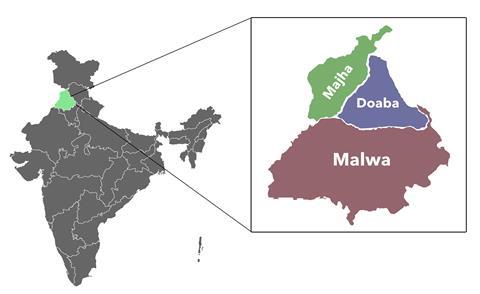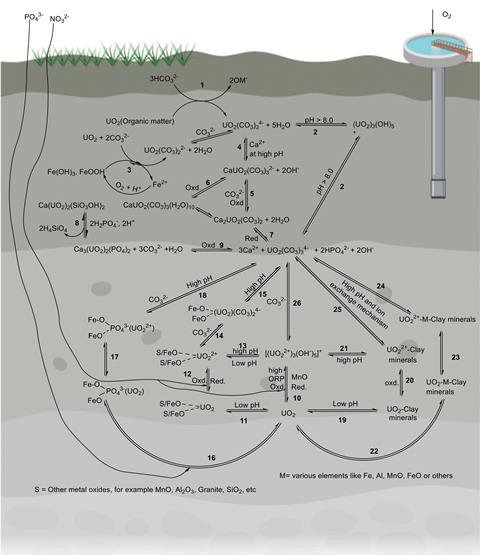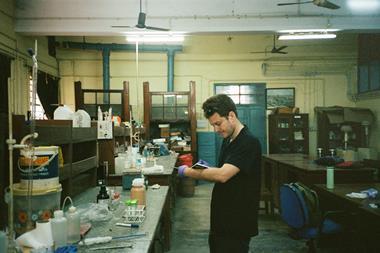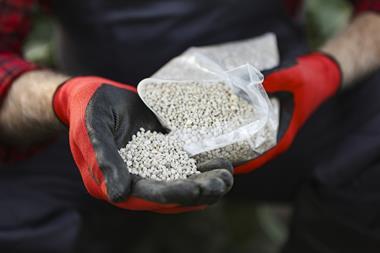As Vajinder Kumar saw more and more cases of cancer in young and old as he travelled through village after village in the Malwa region in northern India he became increasingly concerned. ‘In one village I saw 30 cases of cancer, in another 25, and many people living with brain and nerve disorders,’ says Kumar, a chemist at Akal University, who has visited more than 100 villages over the past six years, mainly in south-west Malwa. ‘In one centre for children, I saw 500 cases of children severely affected with developmental problems.’ The grandparents and parents of the affected children say there is no family history of such developmental disorders.

A study by a team of scientists from universities in Punjab, Sikkim and West Bengal, including Kumar, describes how uranium, arsenic and other toxic elements are mobilised in aquifers and surface waters, contaminating drinking water and irrigation in Punjab. It is but the latest in a series of reports on how uranium, arsenic and other contaminants plague a number of regions in the country.
The latest exhaustive review of over 200 reports and analysis of the physical and chemical parameters of the entire Malwa region shows that its groundwater is unfit to drink. Uranium and arsenic in groundwater pose a significant threat to human health, leading to a high prevalence of cancer. Malwa has a relatively high cancer incidence compared with, for example, Aurangabad district in Maharashtra state in central India, which has low uranium levels and a relatively low cancer incidence (exact figures are difficult to come by for the Malwa region).
‘[Malwa] is also known as the cancer belt of Punjab,’ Kumar tells Chemistry World. Many residents also suffer from other conditions linked to water contaminated with excess fluoride and arsenic. Fluorosis is characterised by dental and crippling bone problems, while arsenicosis or arsenic poisoning is characterised by cancers and skin lesions, as well as heart disorders and diabetes. ‘Malwa region needs special and serious attention,’ says Kumar.

Not all scientists agree with linking uranium in groundwater with cancers, however. So far, there is no direct evidence that uranium in groundwater is causing cancer in humans, says Prafulla Sahoo, Vale Institute of Technology, Brazil. Sahoo and colleagues at the Central University of Punjab and researchers from Brazil and Canada reported ‘very severe’ uranium contamination in shallow aquifers less than 60m deep in south-west Punjab in 2022.
Groundwater contamination with uranium is linked to kidney failure, however, which is very common in Malwa region, says Sahoo. For cancer, other factors such as pesticides should be also be considered along with geological contaminants, he adds.
Unfit to drink
Many states in India have groundwater that is contaminated with unsafe levels of fluorides, arsenic and uranium. Official figures released earlier this year show that uranium levels in India’s shallow groundwater are as high as 532μg/l in some areas, compared with the World Health Organization (WHO) and Bureau of Indian Standards recommended limits of 30μg/l in drinking water. The worst-affected states, in terms of percentage of wells with uranium levels higher than 30μg/l, are Punjab, where Malwa is located, where 29% of wells are contaminated, Haryana with 14.4%, Uttar Pradesh with 9.2%, Rajasthan with 8.6% and Delhi with 3.9%. All five states are in north-western India. Other states with uranium levels above the WHO’s limits include localised pockets in Gujarat state in western India, Madhya Pradesh and Chhattisgarh in central India, Tamil Nadu and Telangana in southern India, and Odisha and Bihar in eastern India. A 2020 survey of uranium in India’s groundwater found that out of 765 districts, 151 spread across 18 states are partly affected by high levels of uranium above the WHO safe limit. Approximately 700 million Indians living in villages depend on groundwater to meet their needs and 85% of rural households rely on groundwater, compared with 45% in cities.
Uranium, along with arsenic and chromium, are the groundwater contaminants of most concern. Certain types of soil and rock, particularly granite, contain uranium, where it occurs in bivalent, trivalent, tetravalent, pentavalent and hexavalent states. Uranium’s toxicity depends on its solubility and it is the hexavalent state that is of most concern.
The metal normally forms uranium oxides which are largely insoluble, and so have low toxicity. However, soluble compounds containing uranium can become concentrated in the kidneys and the bones. Uranium’s radioactivity is also a potential cause for concern if soluble compounds are ingested in high amounts, however its chemical toxicity is of more concern at the levels routinely found in groundwater.

Uranium mostly exists in soils and sediments as quadrivalent minerals, such as uraninite, associated with igneous rock, black shale or granite, and is generally insoluble in groundwater. However, human activities such as mining, excessive use of phosphate and nitrate fertilisers, and over-extraction of groundwater all play a key role in mobilising uranium.
There are areas without uranium mines that still have high levels of uranium and/or arsenic in groundwater, points out Tarit Roychowdhury from Jadavpur University. Much of this could be due to excessive use of nitrate-containing fertilisers. ‘The higher the nitrates in groundwater, [the] higher the levels of arsenic and uranium.’ The nitrates from inorganic fertilisers are thought to react with uranium minerals, releasing the element, he adds.
Punjab, and especially Malwa, has many of these activities going on that can release uranium. Malwa has two of Punjab’s biggest coal-fired power stations, which generate uranium-contaminated fly ash. There has also been a sharp drop in groundwater levels, due to over-exploitation for agriculture, industry and domestic use – something that induces oxidising conditions that promote the formation of soluble uranium complexes.
This problem isn’t unique to India. China, Bangladesh and Pakistan also share similar hydrological features and elevated uranium concentrations have been recorded in several regions. The severe uranium pollution seen in the middle and eastern Sindh and Punjab regions of Pakistan is also seen in the adjoining Punjab and Rajasthan states of India, for instance.
Globally too, very high concentrations ranging up to 1400µg/l have been reported in other countries in North America, central Africa, Asia Minor and south-east Asia. Natural conditions influence the uranium concentration in groundwater such as bedrock geology, water chemistry and redox conditions, while human activities play a role too.

This interplay of local geology and overexploitation of groundwater for agriculture has resulted in elevated arsenic levels too. Although arsenic exposure through groundwater is a global concern, south and east Asian regions are the worst-affected, primarily due to the local geology, and high rates of water abstraction.
Uranium is just the latest groundwater contaminant being reported in India, in a country that has already been battling excess fluoride and arsenic, sometimes both in the same area. Excess fluoride in groundwater affects large portions of arid and semiarid regions of India. A 27-year field study by a team of researchers from Jadavpur University, Kolkata, which studied the magnitude of groundwater arsenic and fluoride contamination and its resulting health effects from numerous states, reported in 2016 that ‘India is the worst groundwater fluoride and arsenic affected country in the world’. It found excess fluoride in the groundwater of 20 of the country’s 29 states. More than 66 million people are estimated to be suffering from crippling fluorosis, including six million children under 14. Excess fluoride can cause a crippling disease, with abnormal tooth enamel in children, and joint and limb pain and deformities in adults. Particularly at risk were people in six states of the Ganga–Brahmaputra plain where arsenic is also present in groundwater along with fluorides.
Roychowdhury explains that in acidic soils, arsenic and fluoride can both contaminate groundwater simultaneously. The main source of arsenic in India’s groundwater is alluvial sediment, mainly from the Himalayas due to erosion. A 2023 study of schoolchildren in an arsenic-affected area in West Bengal, led by Roychowdhury, reported high levels of arsenic in their urine, hair and nails. ‘Drinking water is the main risk factor and the leading future cancer risk-carrying component for the community,’ the authors write. ‘The non-cancer risk assessment study too reveals non-cancerous health hazards in the near future of the exposed population. These results are an alarming signal of chronic health challenges for the future generation.’

Arsenic is present in groundwater in two forms – organic arsenic compounds which are non-toxic and inorganic arsenic which is toxic and carcinogenic, and exists as trivalent arsenite and pentavalent arsenate. Both states of arsenic strongly adsorb to iron oxide minerals, and to amorphous ferric hydroxide in soils and sediments. As iron hydroxide complexed with arsenic dissolves in more acidic conditions, the bound arsenic is released and can leach into aquifers and other water sources.
Several mechanisms that trigger the release of arsenic bound to minerals have been suggested. One is oxidation which releases sequestered arsenic. This can be triggered by a number of factors: frequent withdrawal of water from the aquifers via wells allows oxygen into aquifers and nitrates from fertilisers can oxidise minerals under acidic conditions. A second proposed mechanism is the reduction of arsenic-containing minerals in the presence of organic matter and the absence of oxygen. And some scientists suggest both mechanisms could be at play.

Sourcing solutions
However, there are reasons for hope. Solutions to the issue of groundwater contamination to remove uranium and other contaminants are being rolled out now.
In the case of uranium, for example, remediation depends on the state of uranium, the presence of other contaminants and the water’s composition. Physical and chemical means to treat water contaminated with uranium are considered simpler and more-cost-effective than biological means.
One of the ways of tackling uranium in drinking water is adsorption, which uses resins, activated carbon, activated silica and titanium as adsorbents. Other physical remediation methods include membrane separation technologies such as reverse osmosis, evaporation and coagulation. Chemical remediation techniques include ion-exchange, precipitation and co-precipitation. Similar technologies to those employed for uranium have also been proposed to remove fluorides from water.
A 2022 study by Roychowdhury’s team followed patients suffering from arsenic poisoning who were given access to water treated using slow sand filtration followed by a disinfectant. The researchers found that levels of arsenic in patients’ urine decreased by 43% and arsenic in hair and nails declined by over a third after six months.
A wide range of technologies now exist to remediate contaminated groundwater, says Roychowdhury. Remedial measures range from removing contaminants from groundwater after it is extracted, searching for alternative aquifers, reducing contaminant levels within the aquifer itself and blending with potable water. Techniques to deal with contaminated water after extraction include adsorption using activated media such as alumina or filters that can bind soluble arsenic electrostatically. Membrane technologies that act as selective barriers to contaminants are under investigation too. Bioremediation using plants and microorganisms is also being tested.
Presently, the most widely used treatment for arsenic-contaminated water is adsorption. In India co-precipitation is also being applied in a cost effective way in household arsenic remediation technology in west Bengal. Among the various removal technologies in use iron co-precipitation with lime has been reported to be the most effective.
However, the problem won’t be simply fixed by installing these technologies around the country. The problem in India, explains Roychowdhury, is that their deployment in rural areas, where they’re often most needed, isn’t always successful as they are hampered by problems of poor awareness, improper maintenance of equipment, and poor monitoring and evaluation.
This article was updated on 26 June to correct the map depicting the Malwa region












No comments yet